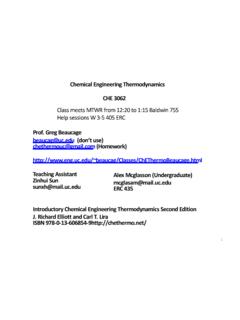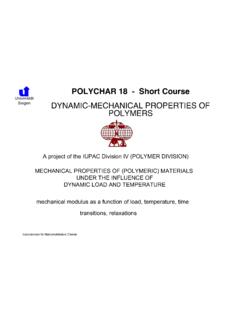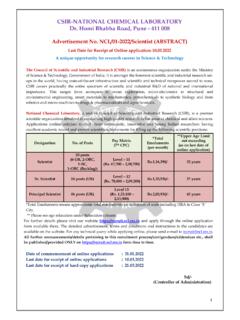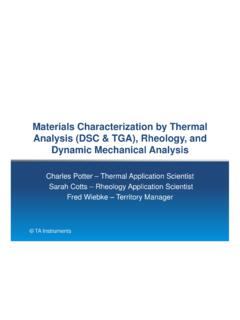Transcription of 1/2000 - University of Cincinnati
1 Interpreting DSC curvesPart 1: Dynamic measurementsThe art of interpreting curves has yet to be integrated into commercially available com-puter programs. The interpretation of a DSC measurement curve is therefore still some-thing you have to do yourself. It requires a considerable amount of experience in thermalanalysis as well as a knowledge of the possible reactions that your particular sample article presents tips and information that should help you with the systematic inter-pretation of DSC artifactsThe first thing to do is to examine the curve for any obvious artifacts that could lead to apossible misinterpretation of the results.
2 Artifacts are effects that are not caused by thesample under investigation. Figure 1 shows examples of a number of such artifacts. Theyinclude:a) An abrupt change of the heat transfer between the sample and the pan:1) Samples of irregular form can topple over in the ) Polymer films that have not been pressed against the base of the pan first changeshape (no longer lie flat) on initial warming. Afterward, on melting, they make goodcontact with the pan (Fig. 2).b) An abrupt change of the heat transfer between the pan and the DSC sensor:1) Distortion of a hermetically sealed Al pan due to the vapor pressure of the ) Slight shift of the Al pan during a dynamic temperature program due to differentcoefficients of expansion (Al: ~ 24 ppm/K, DSC sensor ~ 9 ppm/K, see also Fig.
3 2).This artifact does not occur with Pt pans (~ 8 ppm/K).3) The measuring cell suffers a mechanical shock: The pans jump around on thesensor and can move sideways if they do not have a central locating for users ofMETTLER TOLEDO thermal analysis systems1/2000 ContentsTA TIP Interpreting DSC curves;Part 1: Dynamic measurementsNEW in our sales program DSC822eApplications The glass transition from the point ofview of DSC measurements;Part 2: Information for the character - ization of materials thermal values of fats: DSC analysisor dropping point determination?
4 The use of MaxRes for the investiga-tion of partially hydrated Portlandcement systems Vitrification and devitrificationphenomena in the dynamic curingof an epoxy resin with ADSC Expansion and shrinkage of fibersTips The cooling performanceof the DSC821eDear Customer,The year 2000 should prove to be extremely interesting for METTLER TOLEDO thermalanalysis. We plan to expand the very successful STARe product line with the introductionof an exciting new instrument for dynamic mechanical of course the current thermal analysis instruments have been undergoing continuousdevelopment.
5 In this edition of UserCom, we are delighted to present the new 1/20002c) The entry of cool air into the measuringcell due to a poorly adjusted measuringcell lid leads to temperature fluctuationswhich cause a very noisy ) Electrical effects:1) Discharge of static electricity in ametallic part of the system, or powersupply disturbances (spikes)2) Radio emitters, mobile (cellular)phones and other sources of highfrequency ) A sudden change of room temperature, through ) The lid of the pan bursts as a result ofincreasing vapor pressure of the produces an endothermic peak witha height of mW to 100 mW depend-ing on the quantity of gas or ) Intermittent (often periodic)
6 Closing ofthe hole in the lid of the pan due todroplets that condense or to samplesthat ) Contamination of the sensors caused byresidues of a sample from previousexperiments. The thermal effectscharacteristic for this substance alwaysoccur at the same temperature. Thisproblem can often be overcome byheating the system in air or type of artifact is very dependent onthe contaminant. Artifacts caused bypans that are not inert also look verysimilar. Figure 3 shows an example can also interfere with automaticevaluations (with EvalMacro), especiallythose using automatic artifacts that have been definitelyidentified as such can be eliminated fromthe measurement curve using conditionsYou define the temperature range and theheating rate for the measurement based onyour knowledge of the physical and chemi-cal properties of the sample.
7 Choose a temperature range that is onthe large side. At a heating rate of 20 K/min,you do not in fact lose too much time ifthe range measured is 100 K too information on this can befound in UserCom 3. Use a sample weight of about 5 mg forthe first measurement. Make a note ofthe total weight of the sample and panso that you can detect a loss of weight byFig. 1. DSC artifacts (details are given in the text): An artifact can very often be identified by repeat-ing the measurement with a new sample of the same substance and observing whether the effect oc-curs again either at the same place or at a different place on the curve.
8 Exceptions to this are f and h,which can be very after the analysis . The firstmeasurement is often performed using apan with a pierced lid and nitrogen as apurge gas. The first heating curve is usuallymeasured from room temperature to thedesired final temperature at a heatingrate of 20 K/min. Interpretation is often facilitated bymeasuring a cooling curve directlyafterward. The cooling rate that can beused depends on the cooling optioninstalled in your system. It is a good idea to heat the sample asecond time.
9 Differences between thefirst and the second heating curves canbe very informative. Another helpful variation is to shockcool the sample after it has been heatedfor the first time to the final tempera-ture. This freezes any possible meta-stable states. The sample is thenmeasured a second time. A very conve-nient way to shock cool the sample toroom temperature is to use the auto-matic sample robot. It deposits the hotsample on the cold aluminum turn-table, which cools it down to roomtemperature within a few seconds.
10 If youdo not have a sample robot, you canwait until the sample has reached itsfinal temperature and then remove thepan with tweezers and place it on a coldaluminum surface (with a 2 mmdiameter hole for the pin) or immerse itfor about 10 seconds in liquid 2. Above: Artifact due to a PE film that was not pressed down firmly in the pan (dotted line). Thesample of film that was pressed down on the base of the pan with the lid of a light Al pan gave the"correct" melting : DSC heating curve of mg polystyrene showing a typical artifact at about 78 C caused bythe thermal expansion of the Al pan.













